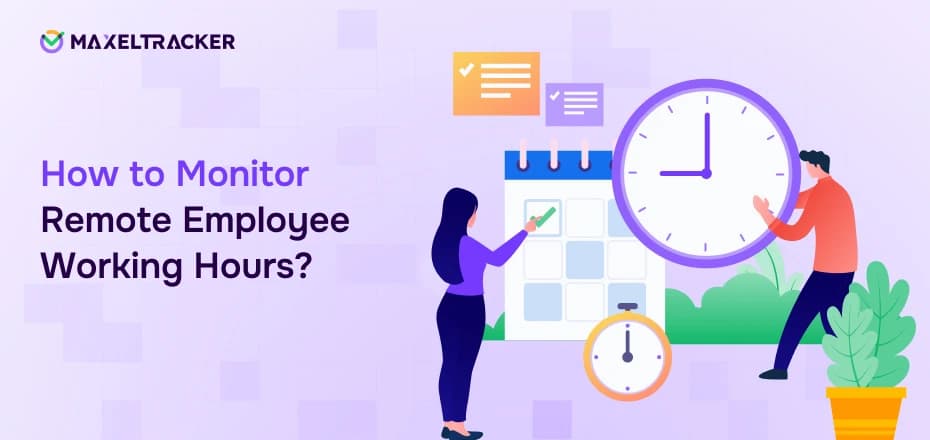

According to McKinsey’s American Opportunity Survey, 35% of employees have the opportunity to work remotely five days a week, while 58% of employees do remote work at least one day per week. Employers must come up with ways to track the time of remote employees in light of this change in order to protect against possible productivity drops and time theft. The easiest way to do this is to track the time of remote team with an employee productivity tracking software.
However, what are the best ways to determine which remote employees tracking solution is appropriate for your business? In today’s guide, we will cover the advantages of using software as well as the features you should be on the lookout for. We will also provide some advice and examples of well-known remote employee time-tracking solutions to help you select the best platform for your company.
Monitoring the efficiency and productivity of remote employees is crucial to maintain business performance, as working from home trend has grown in recent years. The difficulty of keeping an eye on remote employees has grown in importance in today's fast-paced, tech-driven workplace.
It might be difficult to ensure employee performance, productivity, and efficiency as more and more businesses implement flexible and remote working practices. To address this, companies are increasingly investing in employee management systems that streamline workforce monitoring, task allocation, and performance analysis.
In this procedure, remote employee monitoring is essential since it allows managers to assess each team member's contributions and base choices on their performance. However, maintaining a safe and effective workplace requires striking a balance between monitoring and employee privacy.
The need for effective employees attendance monitoring system increases as remote work becomes more common. Although it can be tempting to imagine working remotely as a place of unrestricted freedom, there are some possible drawbacks. According to the National Bureau of Economic Research (NBER) research, full-time remote employees were 18% less productive than their equivalents who worked in offices. The significance of efficient monitoring technologies is demonstrated by this statistic.
In this situation, remote employee time tracking solutions might be extremely important. These solutions can help managers effectively allocate resources, ensure data security, and offer insights into employee activity. So, how time monitoring software is the best solution for remote employees?
With the Employee tracking tool, you can get the following benefits:
Encourage Accountability: Employee motivation to stay on task might be increased by knowing that a system is in place.
Protect Sensitive Data: Businesses can prevent possible data breaches by using the appropriate software.
Promote Team Collaboration: Many monitoring tools have features that encourage communication and teamwork.
Accuracy: You have access to far more accurate data than you would with manual timesheets. By doing this, you can prevent overpayment or underpayment and keep accurate records.
Convenience: Managers can effortlessly track team from any location at any time using a computer or mobile device by using overtime tracking software.
Transparency: It is simpler to monitor productivity and identify possible performance issues when you have real-time visibility into employee hours and work.
Compliance: You may maintain compliance with labor laws and regulations by using the right software.
But it's important to find equilibrium. Ethical employee monitoring strategies can help companies ensure that using remote monitoring tools aligns with transparency, fairness, and employee trust.
It is essential to have a robust monitoring system to overcome the challenges of working remotely. We suggest the following monitoring techniques to help the business to keep an eye on their employees working from home.
Tools for Remote employee monitoring are crucial for improving operational efficiency, protecting company data, and getting insightful knowledge about employees' productivity. Modern employee monitoring software provides real-time employee screen tracking, productivity analysis, and comprehensive reporting to help businesses maintain transparency and efficiency.
From screenshots to keystrokes and app usage, these technologies can monitor a variety of activities. But rather than invading the employee's computer’s privacy, the objective is to:
Maintain adherence to the organization’s personnel management policies in order to provide a transparent and effective working environment.
Continue to operate with excellent efficiency. Make it possible for data-driven feedback and effective resource allocation.
Try to reduce the challenges of working remotely. Maintain team focus and productivity outside of the traditional office environment.
To prevent data breaches and insider threats, notify administrators of any unauthorized or suspicious activity.
By offering useful data and valuable insights, employee monitoring software allows businesses to thrive. It assures that security and productivity coexist despite the geographical separation of team members, different time zones, and irregular work schedules.
Employers may ensure equitable workload distribution, timely project completion, and insight into whether employees require constructive feedback or healthy feedback by using time monitoring systems to keep an eye on employees during work hours, breaks, and overtime. Organizations can also incorporate cost-effective employee monitoring solutions to optimize productivity while managing expenses effectively.
The advantage of time monitoring tools is obvious, regardless of policy parameters; administrators can log in and examine employee time spent during a workday, determining which employees attempt to hide periods of inactivity, which may be experiencing burnout, and which employees self-manage tasks and goals.
Regular Check-ins with employees are an essential way to increase productivity and engagement, particularly in remote work settings when in-person meetings are limited. Whether they be daily, weekly, or monthly, these scheduled meetings give managers and team members specific time to connect and work together.
Discuss ongoing projects: Examine progress, pinpoint roadblocks, and come up with obstacles.
Addressing Challenges: Provide Support and guidance to overcome obstacles.
Setting Clear Expectations will help to ensure that priorities and goals are in line.
Acknowledging achievements: Give credit where credit is due.
Since digital communication is an essential component of collaboration, project management and development in remote work environments, it is crucial to track employee idle time and content inside the teams and comparable communication platforms. Tracking employee performance provides valuable insights into team dynamics, workflow efficiency, and overall productivity.
Thoughtful monitoring provides valuable insights into:
Team dynamics: Recognize how groups work together and interact.
Effective communication: Make sure that all messages are understandable and useful.
Workflow efficiency: Locate bottlenecks and optimize processes.
Time allocation: To enhance time management and project priority, examine the patterns of consumption.
Monitoring remote employees helps businesses by providing them with useful information about the effectiveness and productivity of their employees. If a business is willing to establish, study, and refine productivity monitoring policies, procedures, and technologies, there can be benefits.
Employee productivity can be increased by using remote monitoring, which gives a clear picture of how employees allocate their time and resources when working remotely rather than in an office setting. Implementing strategies to boost workplace productivity and the monitoring of important metrics such as project timelines, active hours, and task completion rates, managers can obtain a comprehensive understanding of both individual and team performance.
Managers may customize their leadership and support tactics to meet the unique needs of each team member using this data-driven approach, creating an atmosphere that encourages productivity. Also, knowing that their work habits are being watched encourages employees to maintain concentration and better match their efforts with company objectives, which increases overall productivity.
A company's security posture is greatly strengthened by remote employee monitoring, which provides better control over user activity and permissions and data access across decentralized work environments. Through real-time monitoring of digital activities, businesses may identify and address possible security risks.
This monitoring approach makes it possible to identify odd patterns of behavior or possible security breaches—like misuse of company resources or illegal access to private data—early. Businesses may quickly respond to and mitigate security issues, reducing the chance of data leaks or cyberattacks, by establishing warnings for particular activity and keeping thorough logs of user actions.
Furthermore, monitoring software frequently includes tools that compel adherence to business policies and data protection laws, such as alerts about app usage or illegal data downloads, which enhance security measures even more.
Organizations can protect their digital assets and create a culture of responsibility and knowledge regarding cybersecurity by adopting monitoring tools and policies carefully. This way, their remote workforce is turned into a line of defense rather than a vulnerability.
Efficient monitoring secures consumer information and intellectual property from illegal access and leaks. When employees are spread out geographically, remote employee monitoring plays a critical role in minimizing data loss by assuring that private data stays inside the organization's safe boundaries.
By properly monitoring and managing data flow and access, businesses may significantly reduce the risk of unintentional leaks or malicious theft. IT security personnel are notified in real-time of any unauthorized or questionable activity via monitoring technologies, which offer a thorough picture of file movements, email exchanges, and database access.
This degree of monitoring makes it possible to investigate and contain possible data breaches quickly, protecting customer information, intellectual property, and other important data from insider threats and outside threats.
Additionally, remote monitoring ensures adherence to data protection laws, strengthening the company's dedication to data integrity and security. Businesses may ensure their long-term stability and credibility in the digital age by maintaining a robust defense against data loss through careful monitoring and analysis. Solving remote work challenges with the right employee location tracking tools ensures that confidential business data remains protected, even when employees are working from different locations.
With the help of MaxelTracker, a robust employee tracking software, you can protect company data, maximize efficiency, and foster a flourishing remote work culture.
Here are some ways MaxelTracker can assist you in efficiently overseeing your remote team members:
Tracking user activity: Learn everything about an employee's activities, including keystrokes, internet visits, and track app and website usage. Determine any obstacles to productivity and make sure teams are concentrating on their jobs.
Multi-channel monitoring: Keep an eye on communications via chat, email, and social media to preserve a professional online image, assure compliance, and stop data leaks.
Integrations of project management: Identify bottlenecks, obtain insights into project progress, and optimize by integrating with well-known technologies.
Identifying threats and fraud: Real-time notifications and sophisticated algorithms can help you identify suspicious activity and protect your company from insider threats and data breaches.
Prevention of data loss: You can use customizable policies and restrictions to keep sensitive data from leaving your network.
Desktop Control: Remotely access the desktops of distant employees to solve problems and provide support in a timely manner.
Automated Workflows: Use automated workflows to streamline activities and increase productivity for training, onboarding, and other procedures.
Compliance reporting: To prove adherence to internal policy and industry requirements, create thorough reports.
Take control of your workforce with MaxelTracker, the ultimate employee productivity tracking tool. Gain real-time insights, monitor performance, and optimize workflows—all from a single platform. Eliminate inefficiencies, enhance accountability, and drive business growth with data-driven decisions.
👉 Sign up now at MaxelTracker.com and start transforming your team’s productivity today! 🚀
👉 Explore our pricing plans and features to find the perfect solution for your team’s productivity needs! 🚀
Related Blogs

Why 21% of Billable Hours Vanish and 5 Instant Fixes That Work
Remote work is flexible, and it has transformed how your company operates, and it is true for several industries across the world. It brings access to global talent and ensures cost savings. But there’s a catch.

15 Remote Work Challenges Every Business Owner Faces — And How to Solve Them
Remote work rings a familiar bell, and it offers flexibility and global reach as well. But for CEOs, HR heads, and other important position holders across countries like USA, UK, Canada, or UAE, it is often the bringer of stress.

Insightful Alternatives & Competitors
Looking for an alternative to Insightful that offers a more tailored approach to workforce productivity and employee monitoring? We’ve got you covered.